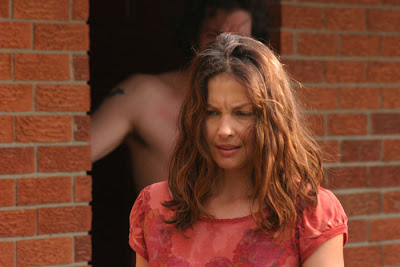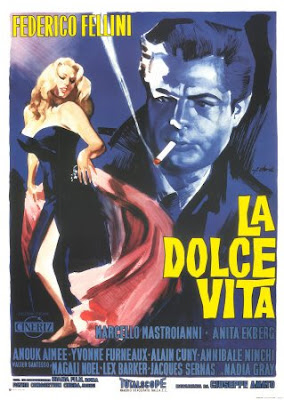 Miss Sadie Thompson. Alas, I will miss seeing the silent film presentation this year of the 1927 film “Sadie Thompson” starring silent legend Gloria Swanson and with a live score performance by the Champaign-Urbana Symphony. I take a little comfort in the fact that I won’t be missing one of the Alloy Orchestra’s wonderful accompaniment scores, but seeing the silent films at the Overlooked has really helped me develop a great appreciation for that bygone era in film.
Miss Sadie Thompson. Alas, I will miss seeing the silent film presentation this year of the 1927 film “Sadie Thompson” starring silent legend Gloria Swanson and with a live score performance by the Champaign-Urbana Symphony. I take a little comfort in the fact that I won’t be missing one of the Alloy Orchestra’s wonderful accompaniment scores, but seeing the silent films at the Overlooked has really helped me develop a great appreciation for that bygone era in film.I tried to get a copy of the film on DVD to my house for a screening, but a series of mail mishaps prevented it from arriving in time for me to view it before this report. As I despaired from having no film to watch for this Overlooked entry, I discovered “Miss Sadie Thompson”, a 1953 sound remake of the W. Somerset Maugham story starring Rita Hayworth. Maugham’s story told the tale of a prostitute trying to escape her past reputation in the Pacific islands, but she is discovered by a missionary who tries to compel her sense of morality to own up to her past. The missionary, Davidson, has his own moral dilemmas to deal with, however.
“Miss Sadie Thompson” updates the story, making the island the heroine ends up on a military base left to ensure stability in the Pacific in the days following World War II. The soldiers on the island haven’t seen any non-native women since their tours of duty began before the war had ended. Sadie’s presence on the island stirs up the GIs in ways they couldn’t even effectively hint at in this production because of the strict production codes of the time. As a result, the first half of the film acts merely as a vehicle for Hayworth to show off her aging beauty, vibrant personality and singing.
The conclusion of the film actually gets rather interesting as Sadie and Davidson must face their difficult moral choices. Sadie must own up to her past, which could mean surrendering to the authorities just when she has developed her first meaningful relationship with a man. Davidson, on the other hand, must realize that for all his moral platitudes, he has the same carnal desires of any man.
Davidson’s story concludes in a shocking, yet true to character manner. But the filmmakers sidestep Sadie’s fate with a happy ending that not only ignores the growth of Sadie’s character, but isn’t even developed. Her happy ending is merely tacked on in a way that betrays any investment the audience has placed in the film.
 Come Early Morning. This is one of those films that makes a film festival like the Overlooked so special. “Come Early Morning” is the writing/directorial debut of Joey Lauren Adams. Some people would know Adams from the roles she has played in independent cult hits, such as Richard Linklater’s “Dazed and Confused” or Kevin Smith’s “Chasing Amy”; she played Amy. I always like Adams as an actress, but I feared for her career because she has such a unique character voice, so leading roles will be limited to independent film and even supporting roles in larger films will start to peter out as she ages. But after seeing what she is capable of as a writer and director, I no longer worry that this major talent will just disappear some day.
Come Early Morning. This is one of those films that makes a film festival like the Overlooked so special. “Come Early Morning” is the writing/directorial debut of Joey Lauren Adams. Some people would know Adams from the roles she has played in independent cult hits, such as Richard Linklater’s “Dazed and Confused” or Kevin Smith’s “Chasing Amy”; she played Amy. I always like Adams as an actress, but I feared for her career because she has such a unique character voice, so leading roles will be limited to independent film and even supporting roles in larger films will start to peter out as she ages. But after seeing what she is capable of as a writer and director, I no longer worry that this major talent will just disappear some day.The film is also a milestone for actress Ashley Judd, who provides the best performance of her career as a woman who “doesn’t do well with relationships.” As Lucy Fowler, Judd portrays a 30-something who has gotten set in her ways. She’s a valuable worker to the construction company that employs her, but she spends her weekends in a pattern of drinking away her nights at a local dive and providing her family healing during the days. Her love life is a series of one night stands until she meets Cal (Jeffrey Donovan), who helps her believe in herself as a good person worthy of someone else’s love.
There is much more to Lucy’s story, but it is the simple way in which it is told that makes it so special. There is little emphasis on the melodrama inherent in this material by Adams, both as writer and director. And the observations of character and life in the south (the story is set in Arkansas) are accurate to the most minute detail and enlightening as to what drives the human spirit through lives that might be described as unexciting. I was reminded greatly of my all time favorite Overlooked film “Tully” while watching this picture; and it is an example of yet another film to which this event has introduced me that I will treasure all my life.
 La Dolce Vita. Believe it or not, I had never seen a film by Italian director Federico Fellini until earlier this month. Perhaps the most universally well-known if the Italian neo-realist directors; Fellini’s impact on film is probably greater than that of his contemporaries because he eventually broke out of the neo-realist movement. He continued to make films of a highly biographical nature, yet became increasingly fantastical. “La Dolce Vita” is the 1960 film that could be sited as the turning point for Fellini from neo-realism into his bio-fantasies.
La Dolce Vita. Believe it or not, I had never seen a film by Italian director Federico Fellini until earlier this month. Perhaps the most universally well-known if the Italian neo-realist directors; Fellini’s impact on film is probably greater than that of his contemporaries because he eventually broke out of the neo-realist movement. He continued to make films of a highly biographical nature, yet became increasingly fantastical. “La Dolce Vita” is the 1960 film that could be sited as the turning point for Fellini from neo-realism into his bio-fantasies.“La Dolce Vita” looks at a series of anecdotes in the life of a journalist, played by the dashing actor Marcello Mastroianni. Marcello is the embodiment of a playboy, and Fellini structures the entire picture around the free-spirited life of such a character, jumping from one sexual encounter to another throughout most of the picture. There are more serious moments of life that creep into the playboy’s life, such as a visit from his estranged father, and moments of psychosis from his possessive fiancée. But most of his adventure is lighthearted.
What starts out as a series of everyday life type of stories, eventually descends into more bizarre encounters, until finally our hero spends an evening of debauchery with a group of costumed partiers. The next morning, after the party has made its way to the beach, there is a moment where Marcello seems to be offered a chance to return to normalcy as a girl calls for him. He cannot hear her, or chooses not to hear her and rejoins the partiers.
I think it is at this point that Fellini leaves the neo-realists behind. Like his hero, he’d rather join the costumed circus of partiers. The fantasy life has set in, and he likes the taste.
I also enjoyed the taste. Not so much for the strangeness of it, but for the richness of Fellini’s world. It is clear his characters enjoy life, even revel in it. It is “the sweet life” indeed.
 Queen: Live at Wembley Stadium. One of the more unusual entries in this year’s festival is a screening of the European television documentary “Freddie Mercury, the Untold Story”. As far as I know this hour-long doc has yet to be aired on U.S. television, therefore I have no idea what secrets it contains. As a replacement screening, I sought out a Queen concert. It seemed the most widely praised of the Queen concerts available on DVD was their famous 1986 concert at Wembley Stadium.
Queen: Live at Wembley Stadium. One of the more unusual entries in this year’s festival is a screening of the European television documentary “Freddie Mercury, the Untold Story”. As far as I know this hour-long doc has yet to be aired on U.S. television, therefore I have no idea what secrets it contains. As a replacement screening, I sought out a Queen concert. It seemed the most widely praised of the Queen concerts available on DVD was their famous 1986 concert at Wembley Stadium.“Live at Wembley Stadium” is nothing outstanding in terms of concert footage, but it is an incredible document of the impressive presence and charisma of Freddie Mercury as a performer. Other than his famous over-bite, he comes across more like a European footballer than the frontman of progressive rock band from the ‘70’s. He commands the audience like a dictator leading his brainwashed followers. Few rockers could allow a stadium-sized audience to sing so many of their lyrics in time and in tune without prompting.
Watching “Live at Wembley”, I was transported to the time of my youth, when the British prog rockers like Queen and Yes were switching from symphonic accompaniment to the more modern power chords of the early ‘80’s, giving their music a new, more sonically powerful life. I remembered sitting in the movie theater during the opening credits of "Flash Gordon", one of the most highly anticipated movies for myself at the time. Today, Queen’s title theme for the film is about the only remnant of that movie that can still be looked at seriously. “Flash” was unfortunately and noticeably absent from the Wembley set list.
While certainly not living up to the quality of films which are the standard of the Overlooked Film Festival, I was glad to see “Live at Wembley Stadium”. It was a reminder of just why the late Freddie Mercury was such an icon and a reminder of a genre of music that once meant a great deal to me. I may just finally drop some money on a copy of “Queen’s Greatest Hits”, just so I can give myself a taste of a true rock classic whenever necessary.





No comments:
Post a Comment